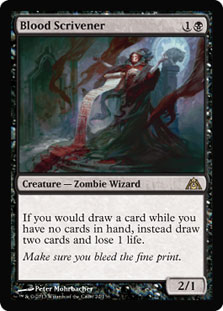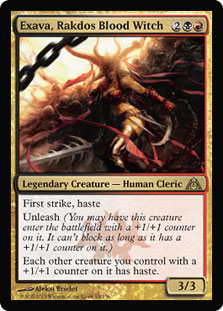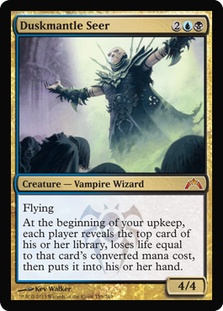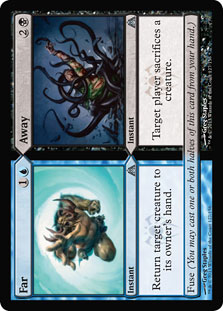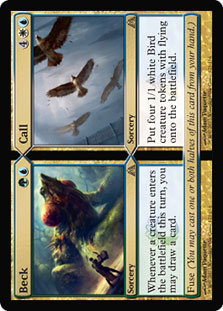The final words of a recent PTQ in Russia included the word “sacrifice” multiple times. Post-combat sacrifices for Falkenrath Aristocrat with Blood Artist in play to pump out the last points of a poor U/W/R pilot’s life total. Can you guess the winner’s deck?
The most logical answer is “The Aristocrats: Act 2,” the deck that has recently had enormous success in the hands of different pilots, including Brad Nelson himself! However, this answer is wrong. Russia is slow in adapting democratic ideals and other good stuff from the West, but we still have enough horses and bayonets, so Sergey Demidov made Top 4 of the WMCQ on Saturday and then won a PTQ with Jund Zombies.
Creatures (29)
- 4 Diregraf Ghoul
- 4 Gravecrawler
- 4 Falkenrath Aristocrat
- 4 Geralf's Messenger
- 3 Blood Artist
- 4 Dreg Mangler
- 4 Lotleth Troll
- 2 Deathrite Shaman
Lands (23)
Spells (8)

Zombies was almost extinct during the last few weeks since people preferred playing faster aggressive decks to beat Reanimator. From the other side, the success of The Aristocrats proves that slower but more powerful decks still have their place in Standard (and don’t forget Andreas Nilsson’s B/R Aggro in the finals of GP Verona). Moreover, Zombies is easier to play than The Aristocrats (that’s probably its biggest drawback) and has enough interesting tools to survive in what should soon be a control-heavy metagame.
Jund Zombies is also good in a creature-heavy metagame because it’s easy to play in defense with Lotleth Troll, Vampire Nighthawk, and cheap removal. I’m not sure if extensive graveyard hate is a good idea—speed is still a better way to beat Reanimator even though Zombies is incapable of non-interactive turn 4 kills. So when I started looking at the metagame of the WMCQ and PTQ, I was a little bit surprised by the popularity of Zombies in Moscow, but by the time it actually happened, Zombies’ win wasn’t surprising to me (even though Sergey had to beat a pair of bad matchups in the Top 8).
Dragon’s Maze will give the deck better removal for bigger threats—old good Putrefy is back in action! Yes, it costs one more mana than Dreadbore, but being instant speed is very important against threats like Obzedat, Ghost Council and Aurelia, the Warleader. The current build of U/W/R seems to be tough matchup for Zombies, but Putrefy should help. Putrefy will also certainly improve the G/B Ooze deck and will see play in midrange Jund decks as a fine removal spell. It can deal with problematic artifacts like Witchbane Orb as well, which will free up sideboard slots for control matchups. But let’s go back to the small dead friends of Thragtusk and Olivia Voldaren.
The most debatable card in Jund Zombies is Blood Artist. An all-star in the slower The Aristocrats, the little Vampire doesn’t help Zombies get aggressive starts, so his place is debatable. There are no good two-mana Zombies to switch with him, making the other contender Knight of Infamy. But Dragon’s Maze is very close to us, so we should consider new card Blood Scrivener as a replacement.
It should probably be a three-of since it isn’t as impressive early as Dark Confidant was, but it is great post-Verdict. Can Blood Scrivener finally put Zombies back on the map of Standard? Probably yes, as Geralf’s Messenger is still one of the best cards in the format. Are there more new cards to support this strategy? Exava, Rakdos Blood Witch has potential as a four-drop, but her lack of both flying and indestructibility will probably keep her out of Standard until the release of Theros.
However, there is another four-mana creature to contest with Falkenrath Aristocrat. He’s not from Dragon’s Maze, but his potential hasn’t been achieved yet. Ladies and gentlemen, Duskmantle “I saw play once and was awful” Seer. Benjamin Brackett recently made Top 16 of SCG Classic Series: Hagerstown with the following deck:
Creatures (25)
- 4 Diregraf Ghoul
- 4 Gravecrawler
- 4 Geralf's Messenger
- 4 Dreg Mangler
- 2 Lotleth Troll
- 3 Deathrite Shaman
- 4 Duskmantle Seer
Lands (22)
Spells (13)
Sideboard

This is an interesting example of true tempo deck with efficient early threats and anti-sweeper countermagic. Such a deck is the best way to capitalize on Duskmantle Seer’s life loss. However, all the Dimir Charms in the world couldn’t counter Supreme Verdict, so I’d cut Deathrite Shaman in the favor of additional Lotleth Trolls and, after Dragon’s Maze is released, Blood Scrivener.
Two cards with embedded life loss may be too greedy, but some combination of the two looks attractive, especially with Ben’s finely selected sideboard options against decks where it wants to be the control. Blood Scrivener and Duskmantle Seer don’t work well with each other, but if your goal is greatness at any cost, playing both is probably your best bet. Blood Scrivener could totally replace Duskmantle Seer, but this probably isn’t a good idea since a tempo deck normally wants to keep an instant or two in hand for its opponent’s actions.
I strongly dislike the lack of Evil Twin in Ben’s deck, but this problem was solved in another Duskmantle Seer deck. Davi Cisne won a WMCQ in Brazil with BUG Aggro, and Nicholas Harry made Top 4 of SCG Classic Series: Hagerstown with a slightly updated list.
Creatures (24)
- 2 Snapcaster Mage
- 1 Evil Twin
- 4 Strangleroot Geist
- 3 Young Wolf
- 1 Wolfir Avenger
- 4 Dreg Mangler
- 4 Experiment One
- 1 Zameck Guildmage
- 4 Duskmantle Seer
Lands (23)
Spells (13)
Sideboard

Finally, a deck where Experiment One and Strangleroot Geist are played together! Rancor, which is hard to cast in Zombies (but I’d still have some there), shines here. The deck looks like the best green-based one for beating control and extremely interesting to play. It even includes my pet card from Gatecrash, Zameck Guildmage! It was wrong to try to build a deck around the small Elf, but he’s totally fine as one- or two-of in a list with seven undying creatures.
Which of the two approaches to BUG is better? I don’t know. We should remember that blue-based complements to these builds may exist too—after all, Delver of Secrets is still legal in Standard. Could BUG Delver with Cloudfin Raptor exist? Probably yes, although they may better together in Zvi Mowshowitz Bant shell, which is criminally underplayed right now. The primary problem keeping Delver of Secrets out of Standard is the lack of library manipulation. Dragon’s Maze will surely not solve this problem, but the new split cards may compensate for it with their outstanding versatility.
However, the best two of the eight split cards spoiled as I’m writing are Far // Away and Turn // Burn, so it may be time for Grixis Control to be in the spotlight. The split cards spoiled thus far have no outstanding halves—their power is in the fuse mechanic and in the versatility they offer, which is exactly what any control deck wants. But the competition is very strong, so something more is needed to turn on new archetypes—at least more spoiled cards. Nevertheless, some cards look like they’ll certainly have homes. Let’s take a look at Jeff Hoogland RUG Flash:
Creatures (15)
Lands (25)
Spells (20)
Sideboard

The thing I’m constantly afraid of when attacking with Huntmaster of the Fells is Restoration Angel. Turn // Burn changes the math of Huntmaster of the Fells’ combat drastically, allowing you to attack much more aggressively. Standard is full of bigger threats right now, but the split card allows you to beat monsters and exchange Wolf tokens for other monsters. Given how counterspell-heavy Jeff’s deck already is, I’d readily exchange some Izzet Charms for Turn // Burns.
Countering Sphinx’s Revelation is great, but Cavern of Souls is widely played while Turn // Burn is a much-needed answer to Obzedat, Ghost Council; Aurelia, the Warleader; and other creatures. You lose the ability to filter bad cards later, but Snapcaster Mage into Turn may easily be the unconditional removal you’d have searched for with Izzet Charm. This is still not as good as Azorius Charm, but there’s certainly nothing better for RUG and Grixis decks.
A note about common Turn // Burn interactions: you can’t play both halves with fuse when Snapcaster Mage is involved; Turn // Burn is not counted as two spells for Ravager of the Fells’ transformation; a Turned Thragtusk will not leave a token; and, finally, the idea of Turning an Angel of Serenity holding three of your creatures is very debatable.
Dragon’s Maze has already provided many more cards than I mentioned today (for example, Council of the Absolute seems like a solid sideboard card in Standard and Block), but there is no way to catch ’em all, especially when there is still a hundred more cards to be spoiled. I’m eagerly awaiting the rest of split card cycle, and I can’t wait to see what Beck // Call does in Modern. Is there going to be a Minotaur hidden inside the Maze, or is Wizards going to waste a great flavor opportunity? They should at least print more Minotaurs in the Greek-themed Theros block…
It seems I have gone too far. Spoiler season is a great time to be a Magic player, so happy brainstorming and brewing!

